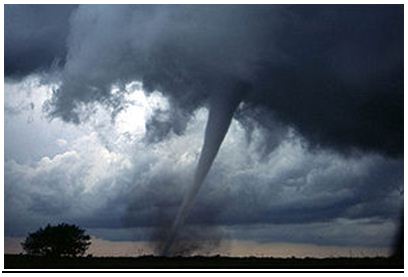Tornadoes are nature’s most violent storms. Spawned from powerful thunderstorms, tornadoes can cause fatalities and devastate a neighborhood in seconds. A tornado appears as a rotating, funnel-shaped cloud that extends from a thunderstorm to the ground with whirling winds that can reach 300 miles per hour. Damage paths can be in excess of one mile wide and 50 miles long.
Some tornadoes are clearly visible, while rain or nearby low-hanging clouds obscure others. Occasionally, tornadoes develop so rapidly that little, if any, advance warning is possible. Before a tornado hits, the wind may die down and the air may become very still. A cloud of debris can mark the location of a tornado even if a funnel is not visible. Tornadoes generally occur near the trailing edge of a thunderstorm. It is not uncommon to see clear, sunlit skies behind a tornado.
The following are facts about tornadoes:
- They may strike quickly, with little or no warning.
- They may appear nearly transparent until dust and debris are picked up or a cloud forms in the funnel.
- The average tornado moves in any direction with average forward speed of 30 MPH, but may vary from stationary to 70 MPH.
- Tornadoes can accompany tropical storms as they move onto land.
- Waterspouts are tornadoes that form over water.
- Tornadoes are most likely to occur between 3 p.m. and 9 p.m., but can occur at any time.
Figure: Tornado [Photo Credit: http://en.wikipedia.org/wiki/Tornado]




